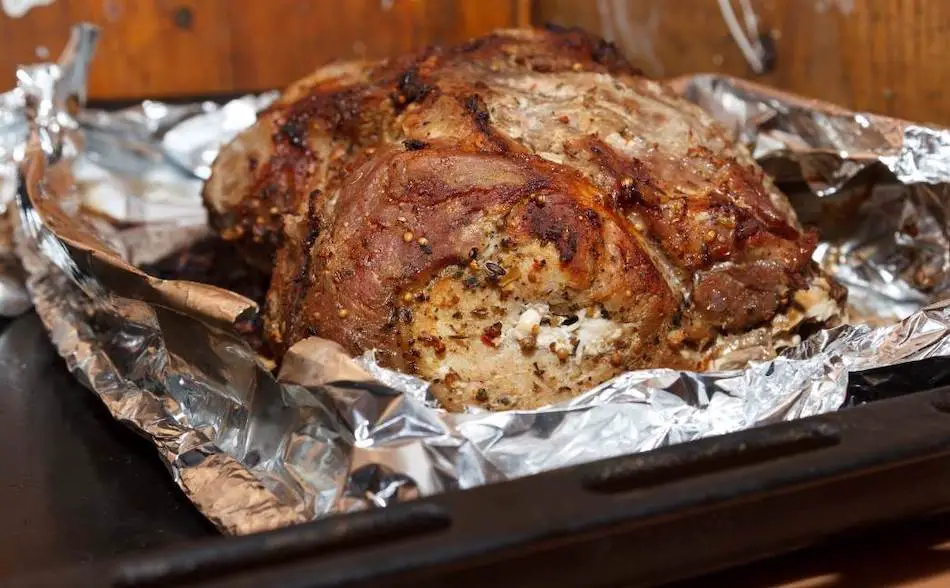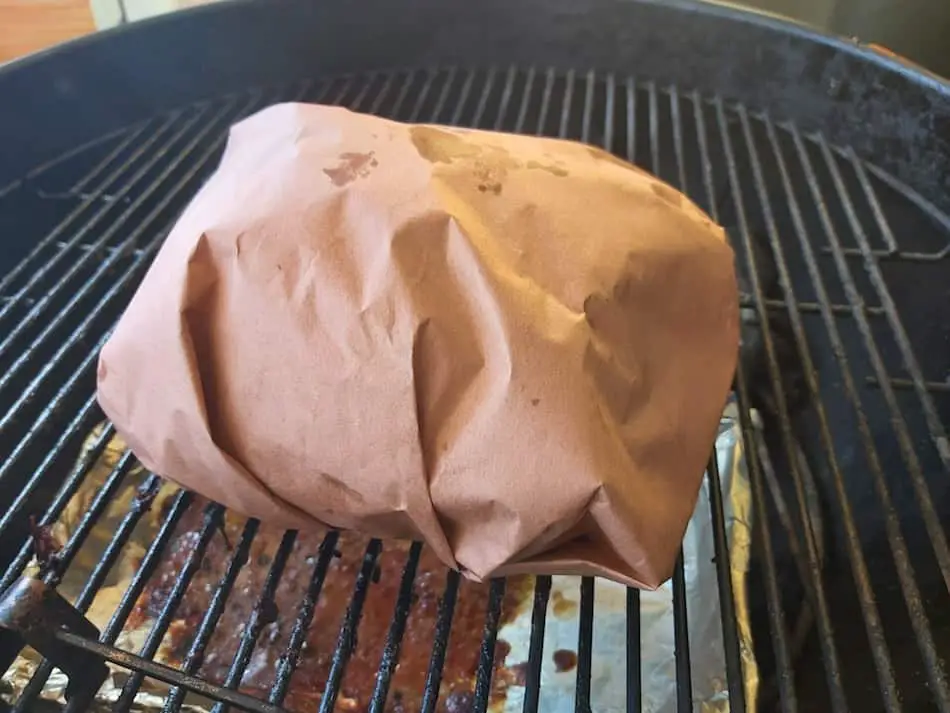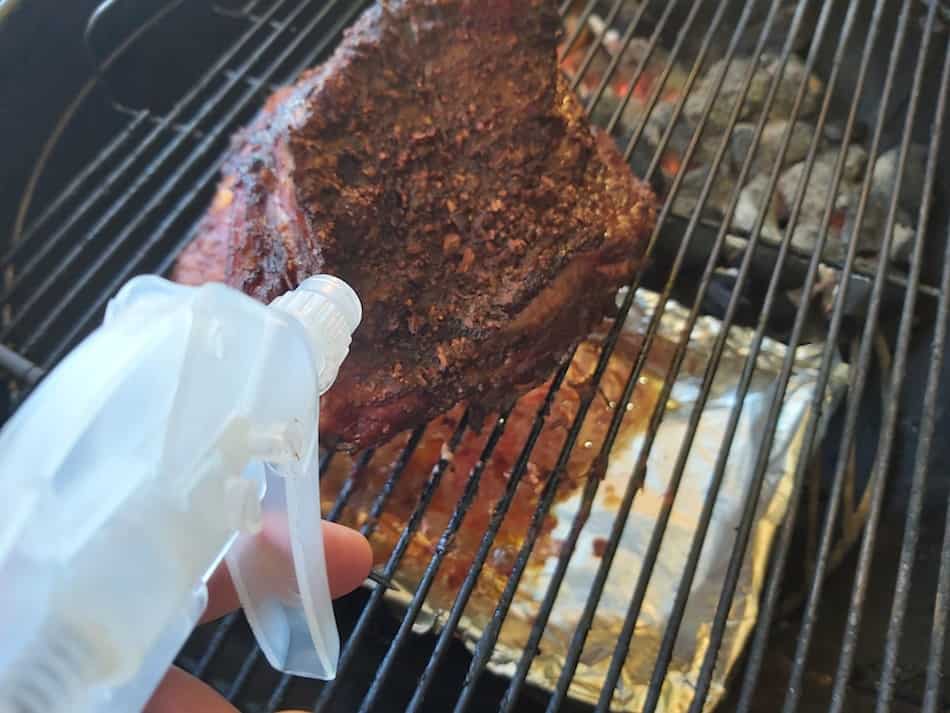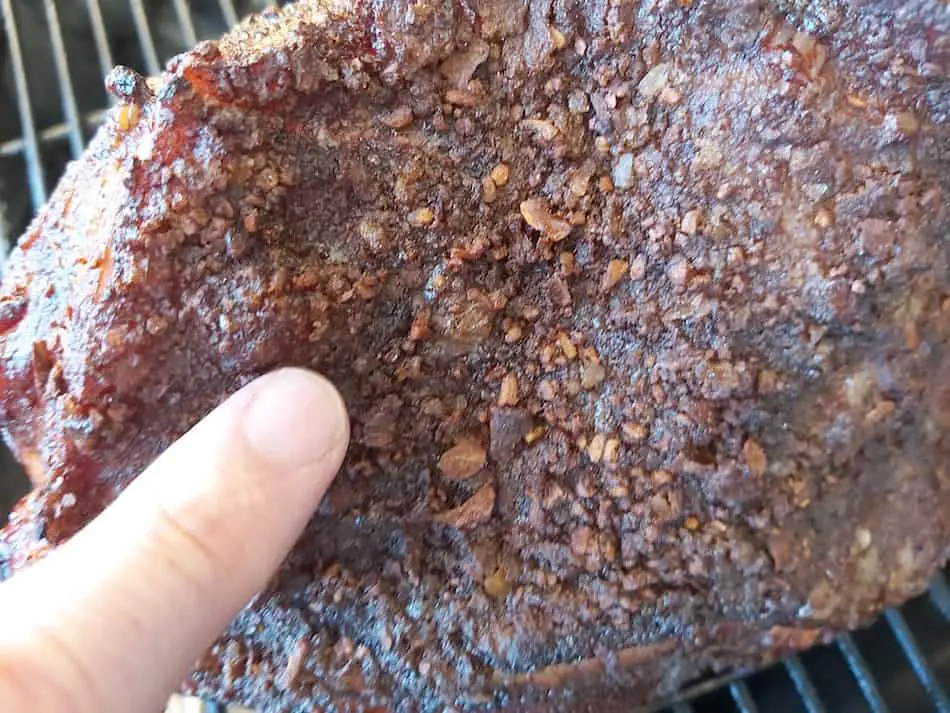
Wrapping pork butt in foil is an important step if you want tender, juicy meat, and it will shave a few hours off the total cook time. However, if the timing is out, you will ruin the bark. I wanted to find out the perfect time to wrap pork butts, so I asked an award-winning barbeque pitmaster how the pros do their butts in competitions.
The ideal time to wrap pork butt once the internal meat temperature has reached around 160°F to 165°F, which should take about 5-6 hours. However, don’t go by temperature alone. Assess the bark before wrapping and ensure the outer crust has set. Wrap the pork butt with two layers of aluminium foil, and spritz the butt before sealing. Insert a temperature probe into the side of the roast and place it back in your smoker until the internal meat temperature reaches 200°F.
Did you know there’s now a meat thermometer with no wires that can control with your phone? Check out MEATER
When To Wrap Pork Butt
| Step | Description |
|---|---|
| Wait until bark is firm and beginning to crack | The ideal time to wrap the pork butt is when the bark is firm and beginning to crack. Once the pork is wrapped, the bark will soften. |
| Wait until internal temperature reaches 160°F-165°F | The ideal time to wrap the pork butt is also when the internal temperature has reached around 160°F to 165°F. It may be higher or lower depending on the bark. |
| Use two layers of aluminium foil to wrap the butt | Wrap the pork butt with two layers of aluminium foil and spritz it before sealing. |
| Insert temperature probe and place in smoker | Insert a temperature probe into the side of the roast and place it back in the smoker until the internal temperature reaches 200°F |
| Wrapping can speed up cooking process | Wrapping the pork butt can help speed up the cooking process by trapping heat and allowing the meat to braise in its own liquid, potentially cutting 2 hours off the total cook time |
Wrapping Makes The Butt Cook Faster
One of the main reasons I wrap my pork butts is to save time. You are probably aware of the stall, the stage of the cook, where a large roast like a pork butt will hit a wall and the internal meat temperature will plateau. In simple terms, the stall is when the meat sweats as moisture makes its way to the surface. The added moisture cools the meat, slowing down the cook. The stall can be extremely frustrating when you’re aiming to have your food cooked by a certain time. Wrapping the butt is by far the best solution to overcome the stall because once the meat is wrapped, the package will trap the heat inside and the meat will braise in its own liquid. A wrapped pork butt could take as much as 2 hours off the total cook time.

Spritz Before Wrapping
Before you close the aluminum foil, give the butt one last spray of apple juice or whatever you ‘re using to mop the meat. Having the extra liquid inside the meat parcel will create more steam, which will speed up the cooking and add more moisture to prevent the butt from drying out. Some pitmasters will also sprinkle some more barbecue rub onto the pork before the wrapping is sealed.

Have you seen the most advanced thermometer on the market? FireBoard can be controlled via your phone, holds meat 6 probes, and records your cook data on a cloud.
Use Heavy Duty Foil
Make sure you buy heavy duty aluminium foil because the cheap stuff tares easily. If you are using the cheap foil, make sure you wrap the butt in three layers. If there’s a hole in the wrapping, not only will steam escape, the precious meat juices will be lost as well. Once you open the foil to slice, you want to save every drop of juice to pour over the meat.
How To Get A Nice Bark
The first stage of the cook is crucial for the development of the bark. During the first 4 to 6 hours, the rub will blend with the smoke, the meat, and fat to form the outer crust. Regular mopping or spritzing plays an important role in bark formation. The added liquid will particularly help the rub fuse to the meat. Once you wrap the butt, it’s game over. The bark won’t harden, it will soften.

Wrapping Makes The Bark Soft
The downside of wrapping pork butt is it will soften the bark, but there is a way to salvage the bark. For starters, make sure you have developed a firm bark to begin with. If the pork butt has formed a hard, crispy layer, it should survive the steam and be dried at the end of the cook.
The best way to dry the bark is to return the roast to the heat after you’ve unwrapped the meat. Place the pork butt back into the pit or onto the grill for about 10 minutes. Slowly rotate the roast until the soggy bark hardens. Obviously, you need to be careful not to dry out the pork, so keep a close eye on it.
The Best Temp For Smoking Pork Butt
I’ve heard a wide range of cooking temperatures for pork butt ranging from the standard 220°F up to 300°F. Pork butt can stand up to the heat more than other roasts, so 300°F won’t do it any harm. I know of one particular pitmaster who has won countless barbecue competitions across America, smoking pork butts at 300°F.
If you want to play it safe, stick with the standard 220°F to 250°F range and you can’t go wrong. However, if you want your food ready sooner rather than later, then crank up the temp to 275°F and save yourself 2 hours.
This brisket injection marinade is the secret used in competitions and made by a World Barbecue champion.
Pork Butt Done Temp
Pork butt is considered done anywhere from 195°F to 200°F. If you’re making pulled pork, the meat should come apart easily if you bring it to this temperature. Carefully monitor the butt once it hits 180F because it can climb to the target temperature extremely fast. You can also finish the pork butt in the oven once you have wrapped it. The pork won’t take on any more smoke flavor after wrapping. The goal of the last phase of the cook is to get the meat to the target temperature, not flavor development.
Insert a Probe
Once you have wrapped the pork, insert a meat thermometer into the roast. Don’t worry about piercing the foil, but just make sure you don’t puncture the pork too many times. After you have wrapped the butt, carefully monitor the internal temperature of the meat and get ready to remove it once the internal temperature gets close to 190°F – 195°F. In the last stages of the cook, verify the internal meat temperature with an instant-read thermometer. Once you get a 195°F reading in multiple areas, remove the butt from the pit.
Best Wood For Smoking Pork Butt
Once your smoker has come up to temperature, throw on 4 or 5 chunks of wood and wait for some nice clean smoke to roll out. Fruit woods blend nicely with pork, so a mixture of apple and cherry will work well. If you want something stronger, mix in some hickory, pecan or oak.
Resting and Holding
Once you have removed the pork butt from the smoker, allow enough time for the meat juices to reabsorb. If you slice too early, the meat juices will spill out onto the cutting board and the meat will turn out dry. High heat and not allowing the meat long enough to rest are two of the most common causes of dry pork.

Wrapping In Butcher Paper
You can also wrap pork butt in butcher paper rather than foil. Butcher paper allows the meat to breathe more than foil, so you end up with a better bark. Make sure you use food grade paper, not parchment paper or kraft paper. Below are the most popular butcher paper brands used by barbecue pros.
My Favorite Meat Smoking Tools
Thanks for checking out this article. I hope you learned a few things. Here are some of my favorite tools I use when smoking brisket that may be useful to you. These are affiliate links, so if you decide to purchase any of these products, I’ll earn a commission. But in all honesty, these are the tools I recommend to my family and friends who are just starting out.
Meat Thermometer: There are dozens of fancy thermometers on the market, but I still use my trusty TP20. For around $50, I have a high-quality meat thermometer with two probes, and can track the temperature of my smoker with one probe, and my meat with the other probe. The ThermoPro TP20 is an Amazon Best Seller because it’s the easiest thermometer to operate, is durable, highly accurate, and comes with pre-programmed meat settings.
Instant Read Thermometer: Arguably, the second most important tool you need is a fast and accurate instant-read thermometer. These tools play an important role in the latter stages of the cook when the meat needs regular checking in multiple areas. I use the ThermoPro TP19 because it can do everything a ThermaPen can do, but for a fraction of the cost. You can check out the TP19 on Amazon here.
Wireless Thermometer: The latest thermometers on the market have no wires and can be controlled by wi-fi via your phone. Airprobe 3 is the best of this technology.
Butcher Paper: Wrapping brisket in butcher paper has become a huge trend in barbeque thanks to Aaron Franklin. Wrapping your brisket in paper will give you a nice brisket bark. However, you can’t just use any old paper, it has to be unwaxed, food grade paper. You can find it on Amazon here.
Advanced Thermometer and Automatic Temperature Controller: Once you’re ready to take things seriously, the FireBoard 2 Drive is a six-channel Bluetooth/Wi-Fi thermometer that can monitor up to 6 pieces of meat, control and graph your cook sessions on your smartphone, and attaches to an an automatic blower that will convert your charcoal smoker to a set-and-forget. This is one of the most advanced meat thermometers on the market. You can check it out on the FireBoard website here.
